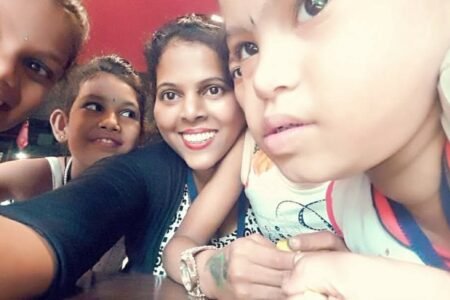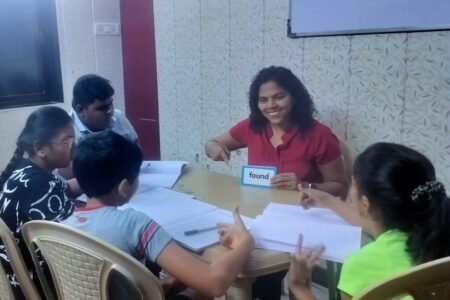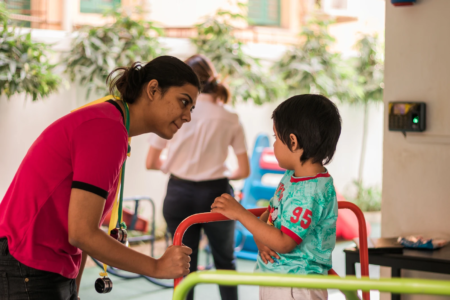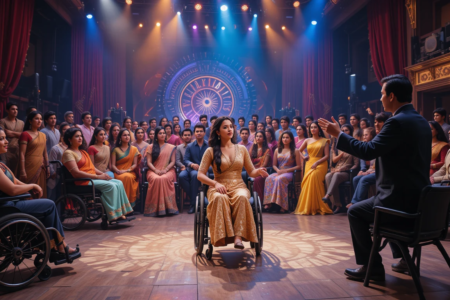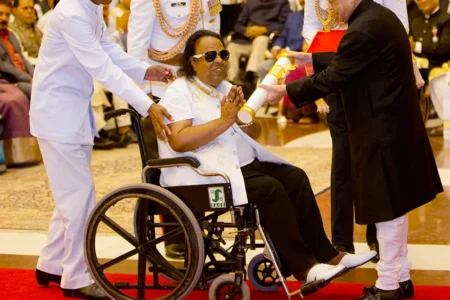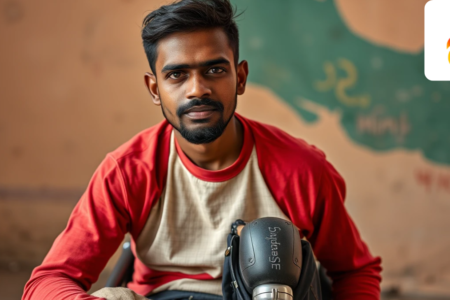“Every child deserves a classroom where they are not just seen, but understood.” In part one of our conversation, special educator Jyotsna Waghmare opened our eyes to the unique learning journeys of autistic children, shedding light on the challenges, misconceptions, and the power of inclusive education. Now, in Part 2, Jyotsna takes us further into the emotional and practical realities of autism education. From creating sensory-friendly spaces to understanding the weight of societal attitudes, she shares insights that are both inspiring and thought-provoking. Her advice for parents, honest reflections on Indian schools, and her heartfelt vision for the future of inclusion remind us that with compassion, awareness, and effort, every child can feel seen, heard, and valued. Q. 1 What role does sensory-friendly learning play in autism education? Ans: Sensory-friendly learning is crucial for teaching children with autism, as many are sensitive to bright lights, loud sounds, and strong smells, while others may not notice them at all. Regular classrooms can feel overwhelming, making it difficult for these children to focus and feel comfortable. Sensory-friendly classrooms are designed to provide a safe environment for various sensory needs, with dimmed lights, low noise levels, and quiet corners for breaks. Tools like fidget toys and noise-canceling headphones can help children stay calm and focused. Supporting a child’s sensory needs leads to better learning, behavior, communication, and social skills. In summary, sensory-friendly learning reduces stress for children with autism, helping them succeed in school and daily life. Q. 2 Advice for parents who are struggling with their child’s learning journey? Ans: To every parent who feels tired, confused, or worried about their child’s learning, please know that you are not alone. Many parents share these feelings, and it’s perfectly normal to have doubts or feel overwhelmed. You are doing your best, and that already means so much. Most importantly, you don’t have to carry this weight alone. Supporting a child with learning needs is a team effort, and it’s okay to ask for help. Reach out to teachers, therapists, and family members. Talk to others and share your concerns; there is strength in working together. Stay involved, remain curious, and ask questions. If something doesn’t make sense, don’t hesitate to speak up. Your voice matters. You know your child better than anyone; your thoughts and observations are important and valuable. Remember, learning doesn’t always come in big leaps. Celebrate the small steps: a new word, a smile, or your child sitting a little longer—these are significant achievements too. Avoid comparing your child to others. Every child is different, and your child is growing at their own pace and in their way. Above all, let your child feel loved, supported, and accepted just as they are. When a child feels safe and believed in, they are already halfway there. You are doing better than you think; your love makes all the difference. Q. 3 How do societal attitudes toward autism impact a child’s education and confidence? Ans: Society’s attitude toward autism plays a powerful role in shaping a child’s learning experience and self-esteem. When people around a child, including peers, educators, neighbors, and extended family, understand and accept autism, they create a world where the child feels seen, valued, and safe. Unfortunately, many children on the autism spectrum still face misunderstanding, judgment, or exclusion. This can manifest as bullying, social isolation, or being underestimated in the classroom. Over time, these experiences can diminish a child’s confidence and make them feel “different” in a painful, limiting way, not because of who they are, but because of how they are treated. The opposite is also true: when children are accepted, encouraged, and respected, they begin to believe in themselves. A supportive environment empowers them to take risks, try new things, and develop a love for learning. Inclusive classrooms and communities not only benefit children with autism but also teach all children that differences are natural and valuable. As educators, parents, and members of society, we all play a part in shaping inclusive attitudes. By talking openly about autism, modeling empathy, and building welcoming spaces, we help children with autism not only succeed in school but also flourish in life. Q. 4 Are Indian schools progressing in terms of autism inclusion, or is there still a long way to go? Ans. Indian schools have made significant strides in including students with autism, but there is still a long way to go for genuine, meaningful change. Improvements: Ongoing Challenges: India is moving in the right direction, but consistent efforts in teacher training and resources are essential for meaningful progress. Q. 5. Your vision for the future of autism education and acceptance? Ans: I envision a future where children with autism are embraced for who they are, not just in specialized settings but throughout society. Schools will become truly inclusive, with adaptable classrooms, child-centered teaching, and compassionate educators. Instead of fitting children into rigid systems, education will evolve to celebrate their unique abilities. In this world, parents will receive understanding and respect, with accessible early intervention and collaboration with professionals as equal partners in their child’s journey. Most importantly, I hope for a shift in mindset, viewing autism as a different way of experiencing the world. Children on the spectrum will grow up feeling proud, confident, and accepted, knowing they belong. With continued awareness, inclusion, and kindness, we can create a more accepting world, one step at a time. Jyotsna Waghmare’s words remind us that inclusion isn’t just a policy—it’s a practice of empathy, understanding, and unwavering belief in every child’s potential. As we close this conversation, we are left with a renewed sense of responsibility and hope. The journey toward autism acceptance in education is ongoing, but with voices like Jyotsna’s leading the way, that future feels not only possible but within reach. Let’s continue to listen, learn, and act—because every child deserves more than just a seat in the classroom. They deserve to be truly seen, heard, and celebrated.
April is observed globally as Autism Acceptance Month, a time not just to raise awareness but to embrace neurodiversity and challenge outdated perceptions. Speaking to Foramz during Autism Acceptance Month, Jyotsna Waghmare, special educator and multiple award-winning founder of Daksinya Academy (a school for children with special needs), has redefined how education for autistic children is approached in India. As Autism Acceptance Month unfolds, her words and work serve as a reminder that inclusion in education isn’t charity; it’s a right. In this exclusive interview, Jyotsna Waghmare shares insights on autism education, common challenges, and what true inclusion should look like in Indian schools. Q.1 How do autistic children typically experience learning differently from neurotypical children? Ans: As an educator, I have noticed that autistic children often learn differently from their neurotypical peers. They tend to be detail-oriented and may excel in subjects that align with their interests, even if their strengths aren’t always visible in traditional classroom settings. Some may struggle with language processing or writing due to sensory sensitivities, but these challenges don’t reflect their true potential. It’s essential to provide opportunities for them to showcase their knowledge in different ways. Sensory issues like sensitivity to noise or light can impact focus and comfort. A calm and structured environment with visual supports can help. Additionally, social interactions may look different for autistic students, and some may communicate in alternative ways. With flexibility and understanding, we can support their unique strengths and help them thrive. Q.2 What are some common misconceptions about autism in the education system? Ans: I often see that many educators and even doctors still hold outdated beliefs about autism, which can limit support for autistic children. A concerning trend is that parents are often advised by pediatricians to focus solely on therapy for a few years, assuming education can wait. As a result, some children begin formal education as late as 8 to 10 years old, making it harder for them to grasp foundational concepts. It’s important to recognize that therapy and education are interconnected. Learning should not be postponed; both can and should occur simultaneously Q.3 How can mainstream schools become more inclusive for autistic students? Ans: Inclusion isn’t about making autistic students fit a traditional mold; it’s about reshaping that mold to meet the needs of every learner. In Indian schools, this shift is essential. First, awareness and training are crucial. Many teachers lack exposure to neurodevelopmental conditions like autism in their training, leading to confusion between behavioral issues and neurodiverse needs. Regular in-service training programs are needed to help teachers understand autism, recognize differences, and develop effective classroom strategies. Next, schools must go beyond token inclusion. Simply admitting a child has autism isn’t sufficient. True inclusion involves dedicated special educators, visual aids, structured routines, and curriculum adjustments. Small changes, like providing extra time for tasks or quiet spaces, can significantly improve the learning experience. Large class sizes and rigid structures are challenges, but affordable solutions like peer buddy systems and visual timetables can foster inclusivity. Schools should shift from a focus on “marks” to “meaningful learning,” prioritizing skill development and emotional well-being alongside academics. Collaborations between schools and therapy centers are essential for coordinated support, and involving parents as active collaborators creates a strong support network. Ultimately, nurturing an inclusive culture through regular activities that promote empathy and respect is vital. Inclusion is a right and a hallmark of a progressive education system. Q.4 What are the biggest challenges special educators face while teaching autistic children? Ans: Teaching autistic children is a rewarding but challenging journey that requires patience and flexibility. Each child is unique; some may be verbal while others are non-verbal, and their interests and focus levels vary greatly. Special educators must adapt their teaching methods to meet these individual needs. Communication plays a vital role, especially with non-verbal children, who may rely on pictures, gestures, or specialized apps to connect. Many children also face sensory issues, where loud sounds or bright lights can lead to meltdowns. Handling these situations requires calmness and knowledge of the child. Collaboration with parents, therapists, and other educators is crucial for the child’s growth, although it can be difficult. Despite limited resources and heavy responsibilities, special educators remain committed to helping children learn and express themselves, finding great fulfillment in their work. Q.5 What are some of the most effective teaching strategies for autistic children? Ans: Teaching autistic children works best when we offer structure, clarity, and flexibility based on their strengths. Here are some of the most helpful strategies we use at Dakshinya: Step-by-step charts and flashcards help children understand tasks and transitions. Predictable routines provide safety, and preparing for changes reduces stress. Teaching is personalized, adapting to how each child learns, whether through touch, songs, play, or videos. Assistive technology, like communication apps and sensory tools, aids expression and focus. We emphasize positive behavior support, using calm responses and positive reinforcement instead of punishment to build trust. Social skills are developed through role-playing, social stories, and buddy systems. Collaboration with parents and therapists is essential, ensuring consistent support and communication, including with mainstream schools. Q.6 How do you personalize learning plans for autistic students with varying needs? Ans: Every autistic child is unique, so teaching them requires understanding their world, strengths, challenges, interests, communication style, and sensory preferences. This personalized approach begins with close observation and gathering insights from parents, therapists, and the child. Based on this information, we create an Individualized Education Plan (IEP) with clear goals tailored to the child’s learning pace, whether they need support in speech, social skills, academics, or daily life skills. Teaching strategies are adaptable, allowing for different learning styles through visuals, hands-on activities, or digital tools. We also make environmental adjustments, such as creating quiet spaces and incorporating movement breaks, to enhance comfort. Collaboration with school counselors and teachers is essential for ensuring consistent support. This joint effort has proven successful, helping many children thrive. At Dakshinya, we regularly update each child’s learning plan
April is here, bringing with it the recognition of Autism Acceptance Month not just a time to spread awareness but a call for genuine acceptance, inclusion, and respect. For years, autism has been talked about in hushed tones, often misunderstood and misrepresented. But today, the conversation is changing, shifting from simply knowing about autism to truly embracing autistic individuals for who they are. What is Autism? Autism, or Autism Spectrum Disorder (ASD), is a developmental condition that affects how a person perceives the world and interacts with others. But there’s no single way autism “looks.” It’s a spectrum, meaning every autistic individual experiences it differently. Some may struggle with verbal communication, while others may be highly articulate but find social interactions overwhelming. Some might have intense passions for specific interests, while others may have sensory sensitivities that make everyday environments challenging. Autism is not a disease to be cured it’s a different way of experiencing life. Why “Acceptance” Over “Awareness”? For decades, society has focused on “awareness,” painting autism as a condition that needs to be fixed or managed. But awareness alone isn’t enough. Imagine a world where people know autism exists but still treat autistic individuals as outsiders. True progress happens when awareness turns into acceptance schools create inclusive learning spaces, workplaces accommodate neurodivergent employees, and communities celebrate autistic individuals for their unique strengths rather than seeing them as challenges to overcome. Breaking the Myths There are many misconceptions about autism, and these myths often prevent true understanding: “All autistic people are geniuses.” While some autistic individuals have exceptional skills, not all are savants like in movies. Each autistic person is unique, just like neurotypical individuals. “Autism is caused by vaccines or bad parenting.” Science has repeatedly debunked these harmful myths. Autism is a natural variation in human neurology, not something that can be “caused” by external factors. “Autistic people don’t feel emotions.” This is one of the most heartbreaking misconceptions. Many autistic individuals experience emotions deeply but may express them differently. The Challenges of Living in a Neurotypical World Despite growing conversations about autism, acceptance remains a challenge. Schools may lack the resources to support autistic students, workplaces often fail to accommodate neurodivergent employees, and society still carries biases that make life harder for autistic individuals. Simple things like too much noise in a public place, unexpected changes in routine, or an unkind stare from a stranger can make everyday life overwhelming. Yet, the real challenge isn’t autism itself. It’s the world’s failure to understand and embrace neurodivergent individuals. Imagine the frustration of a child who is brilliant but struggles in a rigid school system that doesn’t cater to their learning style. Or an adult who is highly skilled but keeps losing jobs because they don’t conform to conventional social norms. These aren’t autism problems they’re societal problems. Looking Ahead: A Month of Understanding Autism Acceptance Month is about listening to autistic voices, amplifying their experiences, and making real changes. Over the coming weeks, this article will explore autism from different perspectives. We’ll hear about autism, from parents about the challenges of raising a neurodivergent child, from educators striving for inclusive learning, and from advocates pushing for policy changes. This isn’t just about reading an article and moving on. It’s about taking a moment to reflect. How can each of us contribute to a world where autism is not just acknowledged but truly accepted? How can we build a society where differences are celebrated rather than tolerated? Acceptance begins with understanding, and understanding begins with listening. Are we ready to listen?
Last week we took to the example of Ravindra Jain, the Maestro who was visually impaired and handicapped. His example can bring inspiration to many, but real problem lies in the mindset of people perceiving them as weak and needy. The underrepresentation and lack of opportunities for disabled individuals in Bollywood is a significant issue. To address this morally and ethically, the industry and society must adopt a more inclusive approach. Here are some possible solutions: Equal Chances for Everyone The film and music sectors ought to focus on employing professionals for their skills instead of their physical capabilities. Skill, imagination, and dedication are what genuinely characterize an artist, and these ought to be the main standards for choice. Regrettably, numerous talented people with disabilities face difficulties in securing jobs due to the absence of inclusive hiring practices in the industry. Casting directors, music producers, and production companies need to make concerted efforts to adopt more equitable hiring practices. A key method to guarantee equitable opportunities is by instituting quotas for disabled actors, directors, writers, and technicians. By reserving a specific percentage of positions for people with disabilities, the sector can assist in disrupting the cycle of exclusion. Nevertheless, inclusion shouldn’t merely be procedural; emotional inclusion holds equal significance. Establishing a workplace where disabled individuals feel appreciated and at ease is equally important as offering them opportunities. By promoting respectful dialogue and removing any feelings of exclusion, Bollywood should aim to build a genuinely inclusive industry. Open Infrastructure If Bollywood genuinely starts to acknowledge and welcome disabled talent, it should also create a system that facilitates their involvement in the industry. In the absence of appropriate physical arrangements, individuals with disabilities find it challenging to perform their jobs effectively and comfortably. Studios, recording booths, and film sets must have ramps, accessible seating, assistive technology, and additional essential facilities to support individuals with physical disabilities. Through these modifications, the sector will ensure that disabled workers have access, while also motivating others to step forward without worrying about logistical issues. Another important factor is transportation. Numerous disabled artists struggle to participate in auditions, shoots, and industry gatherings because of insufficient accessible transportation. The movie industry ought to offer dedicated transportation options to assist Shifting Perception In Bollywood, able-bodied actors frequently portray disabled characters. Although these performances might receive acclaim for their emotional richness, they deprive genuine disabled actors of opportunities to portray these roles with authenticity. This behavior is not just unjust but also conveys the idea that the industry lacks faith in the capabilities of disabled actors. If a character has a disability, the part should be given to someone who truly understands and faces those difficulties. In addition to casting decisions, the representation of disabled people in films needs to transform. Frequently, disabled characters are portrayed as sources of sympathy, merely grappling with their disability. This depiction reinforces stereotypes and alienates disabled people from conventional society.tion of artists, directors, and technicians with disabilities. Such funds can also be used for their training and other ancillary supports that are needed generally in the practice of making films. Rather, Bollywood ought to showcase them as competent, self-reliant persons with unique strengths, aspirations, and obstacles. Representation ought to empower rather than oppress. Movies ought to portray disabled characters as accomplished professionals, romantic interests, or even as action heroes, just like any other roles. Altering the narrative will not only foster improved opportunities for disabled performers but will also transform how viewers understand disability. Support from Financial and Institutional Sources Insufficient financial assistance is a significant barrier hindering disabled individuals from leaving their imprint in Bollywood. Numerous skilled artists, directors, and technicians with disabilities find it difficult to finance essential training, equipment, or chances to present their work. To close this gap, Bollywood ought to create specific funds and scholarships to assist aspiring professionals with disabilities. Genuine inclusivity in Bollywood necessitates a major transformation in both attitudes and frameworks. From equitable hiring practices and inclusive workplaces to proper representation and financial assistance, every facet of the industry must transform to guarantee disabled individuals obtain equal opportunities. Disability ought to be viewed not as a restriction but as an aspect of the human experience. Talent manifests in various forms, and the industry needs to acknowledge, value, and cultivate it without bias. By implementing these measures, Bollywood can serve as a model for the world, demonstrating that genuine storytelling revolves around authenticity, inclusivity, and empowerment. Change has been needed for a long time, and the moment to take action is here. Keep Reading Foramz for your daily dose of moral support.
In the last week, we discussed in detail how people with disability face several hurdles in the challenging industry of Bollywood. Where there is a will, there is a way. Despite the challenges, some people have strived harder and soared in the skies in Bollywood. We can take inspiration from them. This is Foramz and today, we will be exploring the story of Ravindra Jain who with his talent has excelled in the music industry. Ravindra Jain was born in Uttar Pradesh to a middle-class Jain family. He was discovered with his prodigious talent very early in life by his parents. His father was a Sanskrit scholar and inculcated values of perseverance and discipline into him. The emerging talent learned classical music from Pandit G.L. Jain and Janardhan Sharma and honed his craft with dedication. Jain did not let his disability define him. Instead, he used it as a source of strength to channel his energy into creating melodies that would touch hearts. His blindness never became an obstacle to his creativity or his ability to compose complex pieces of music. Ravindra Jain started his career in Mumbai, the city of dreams, with nothing but his talent and determination. In an industry known for its fierce competition, his melodious compositions soon carved a niche. His breakthrough came with the film “Saudagar” (1973), where his soulful compositions caught the audience’s attention. He became a household name with “Chitchor” (1976), a film whose music captured the essence of simplicity and love. The songs, including “Jab Deep Jale Aana,” remain evergreen classics. Jain’s ability to blend Indian classical music with modern cinematic styles made him one of the most sought-after composers of his time. While Jain’s contributions to Bollywood were immense, his devotional music stood out as a significant part of his legacy. He remains the best ever composer for Ramanand Sagar’s television epic “Ramayan.” His bhajans and background scores helped make this series a classic one, making him reach every home and generation of viewers. Millions continue to inspire faith and devotion through his devotional compositions. He even won several awards for his work, including the Filmfare Award for Best Music Director for “Ram Teri Ganga Maili” (1985), and Padma Shri in 2015, one of India’s highest civilian honors. What makes Ravindra Jain’s story inspirational is his refusal to be held by such societal limitations. He managed to peak in an industry where perfection often takes the form of a perfect body. The melodies he created reflected his inner strength and how he could see beauty in the world through his music, which he could not see with his eyes. He passed away on October 9, 2015, but his music lives on, continuing to inspire and uplift. Ravindra Jain proved that talent, when coupled with hard work and resilience, can break every barrier. Jain’s life illustrates how physical handicaps are just no match to the strength and will of mind. His passion for music spurred him to strive and overcome any obstacles. Successful though he had become, Jain never lost himself but always placed the credit to God’s bounty for his good fortunes. Ravindra Jain is a song of hope, the rhythm of perseverance, and the composition of faith in oneself. His life story reminds anyone who is facing challenges that it is not impossible provided the individual is determined, dedicated, and persevering. Seeking inspiration from people like him will help us do better in life. Drawing inspiration from his life, let’s foster a better society for them. Despite the challenges, people with disabilities face, talent and dedication find their way in life. Keep Reading Foramz for your daily dose of Moral support.
In the last week, we saw the state of disabled people and their conditions in Bollywood. Bollywood is an industry where making your name is already a challenging feat. As an aspiring with a disability, it becomes testing to bag a trusting job in Bollywood. Known for its unpredictable and risky job stigma, Bollywood became a place where most people with networks make it easily. Despite India being home to over 26 million people with disabilities (According to the 2011 census), people with employment in Bollywood are scarce. The portrayal and treatment of disabled individuals in Bollywood has been a contentious issue, reflecting border societal attitudes and systemic problems. To resolve any social issue, it is important to understand exactly what are the issues faced by people with Disabilities. This is Foramz and today we will discuss the issues with the handicapped or specially abled in Bollywood. Typical Sympathy portrayal. If you notice, disabled characters are often depicted as objects of pity, charity, or inspiration which reinforces harmful stereotypes. Society is largely influenced by cinema, hence, we end up forming their image as people who need pity or charity. Are they not capable of achieving complex feats apart from their disabilities? Absolutely no. People with disabilities are prone to have more willpower and dedication. Films like Black and Paa revolve around disabilities but are often romanticized or exaggerated to create dramatic effects. Lack of Authentic Representation. Behind the scenes, the film industry remains inaccessible to disabled professionals due to infrastructural, cultural, and attitudinal barriers. Imagine, not being able to find a job because you faced an unfortunate accident. t a feeling of utter helplessness. Despite that, people with disabilities rise from their physical flaws and dare to soar but practical difficulties come in their way. The film Industry remains a space where opportunities are plenty but grabbing them is a challenging task. There are limited opportunities for disabled actors, writers, directors, or crew members. After waiting in line for hours, calling and pitching countless times, there are instances that the filmmakers do not prioritize people with disability regardless of their talent. They have a mindset that it is taxing to work with people with such disabilities. It is important to notice that they deserve a chance too. It is not only about chance, it is about the life and future of an individual. Insensitive Humour Bollywood is incomplete without comedy movies, but there are times when the jokes become insensitive and normalized behind an ethically faulty dogma. For instance, in Housefull 3, the male protagonist is faking various disabilities such as blindness, muteness, and paralysis to gain sympathy and manipulate others. This creates a slapstick comedy out of conditions faced in real life. Such portrayal makes the audience believe that people with disabilities are people who crave sympathy instead of empowerment. This insensitivity towards disability not only normalizes ridicule but also undermines efforts to foster respect and understanding towards disabled communities. It is simple, imagine a person giving you words of sympathy, like it’s okay or you will be fine when you are completely fine. It will make you question yourself whether you are fine or not. The same is true in this case, Disabled communities do not need sympathy because they have accepted their condition. Inaccurate Storytelling Disablities are often poorly researched and misrepresented which leads to misconceptions in people’s minds. Thereby forming a different perception of them and treating them accordingly which is far from reality. For instance, mental health conditions are sometimes dramatized in ways that are not completely true or lack information. This stigmatizes those who experience them. The issues lie in perception. If the way society thinks of them does not change, their issues will never be completely resolved. It is important to see them as they are without forming assumptions about their condition. Prejudice and Discrimination Casting directors and Filmmakers may hold biases believing disabled people might not be capable of fulfilling roles or demanding higher accommodations. Many in the industry prioritize physical perfection and conventional beauty standards which marginalize disabled artists. It is important to acknowledge their talent. Society expects picture-perfect handsome and beautiful actors on-screen which creates unseen expectations for the filmmakers. This results in limited opportunities for disabled people to make it on-screen. Behind the Camera Scenes Jobs like direction, editing, scriptwriting, and production often require long hours of work and are physically demanding work environments. This factor may not be welcoming disabled professionals. The lack of mentorship programs or training initiatives adds up to the issue. Even disabled professionals need training and the right guidance to thrive as much as a healthy-bodies professional needs. Behind the camera, jobs have more people in line. hence, the competition is fierce but there are instances where disabled professionals don’t get a chance to show their skills. Economic Instability Bollywood is a highly competitive and informal market where networking and connections secure jobs and opportunities. Connections and networking often outweigh merit and talent. Disabled individuals lack access to these connections and networks further reducing their chances to reach their professional goals. Studios may perceive accommodations as an additional expense which discourages them from hiring disabled professionals. The issue lies in the roots of the people’s perception. To foster inclusivity and equal opportunities for everyone it is essential to understand disabled individuals. It is important to not judge on their disabilities and to have an open mind while hiring. In the next week, we will look at real-life examples of people with disabilities and how they face struggles and rise with immense willpower. Keep Reading Foramz for your daily dose of moral support.
Bollywood is also known as a destination where dreams are created. The glamorous world has tremendous opportunities to offer from fame, and power to a creative platform for expression, it is all an individual could ever dream about. But are these opportunities accessible to everyone in the country? This is Foramz and today we will talk about how Physically disabled people struggle for an opportunity in the so-called hub of dreams- Bollywood. While there has been a gradual shift of the dreamland towards inclusiveness and diverse representation in cinema, the opportunities for people with disabilities remain limited as these passionate and determined individuals live in the hope of a better future. This disparity stems from societal prejudices, lack of infrastructure,, and stereotypes in storytelling. Bollywood as an industry is widely versatile and have varied job profiles available. Despite such a large vacancies, people who are handicapped yet talented fail to get the opportunity that they deserve. Call it biased society or the authorities mindset of underestimating the talent, it is a social issue which ruins talent and lives. Mumbai the city of dreams, promises hope, fame and money to all but the one who had the courage to leave their hometowns, families and make a career in the city that never sleeps now know why the city never sleeps. It is because the city keeps the dreamers awake, awake until it is dawn and have to work again, awake in thoughts of survival, awake in the memories of their families, awake in the worry of an unmarried sister, awake in the stress of getting the role, awake in striving for that position, awake in proving their worth. People privileged with their healthy bodies do strive but people with physical liabilities have to strive harder. People who don’t have a prosthetic leg work hard but people with a prosthetic leg face issues in walking hard. The difference is that they face great hurdles in performing day to day tasks with ease. Bollywood is well known as a place uninviting for outsiders. People with contacts and networking can get opputunities but people who become handicapped in a tragic incident do not have contacts. Does that mean that they will live a life full of false hopes and sympathies ? Obviously No ! Such people do lose an ability but have mental strength like any other. Their will power is strong but no one can survive in Bolywood only on will. Albeit portrayed by a non-disabled actors, films have been released which depict the struggles of disabled individuals. Advocacy groups and disabilty rights activists push for more inclusivity in casting, scriptwriting and production. Yet the progess remains slow and sporadic which reefelcts socety’s attitides towards disability. Behind the scenes, the hurdles are no less daunting. Basic amenities like wheelchair access, assistive technologies, and supportive work environments are often absent, making it harder for disabled individuals to fully participate in the industry. Lets assume somehow they do get a meaningful opputunity but later, they are bound to face widespread stigma and are often typecast or sidelined, without opputunities to meaningful roles or opputunities. To transform the state of handicapped individuals in Bollywood, systemic reforms are essential. These include proactive casting of disabled actors, making production environments more accessible, and challenging stereotypes through thoughtful and accurate storytelling. Only then can Bollywood become a truly inclusive industry that values talent and creativity over physical abilities Societal attitude towards disabilities compound a problem. There is a perception that individuals with disabilities are less capable of performing more demanding tasks associated with fimlmaking, whteehr on screeen or behinf the camera. This misconception has pushed the opputunities in another direction leaving such talented people without a chance to prove them. All they need is a chance to prove themselves Furthermore, societal attitudes compound the problem. There is a perception that individuals with disabilities are less capable of performing the demanding tasks associated with filmmaking, whether on screen or behind the camera. This misconception fosters an environment where handicapped individuals are overlooked or underestimated, irrespective of their skills or qualifications. This was a glimpse in the life of people with disabilities and their struggles to make it in the bollywood industry. Next time we will be discussing depth about how these struggles are a part of a larger social issue. Keep Reading Foramz for you daily dose of moral support.

